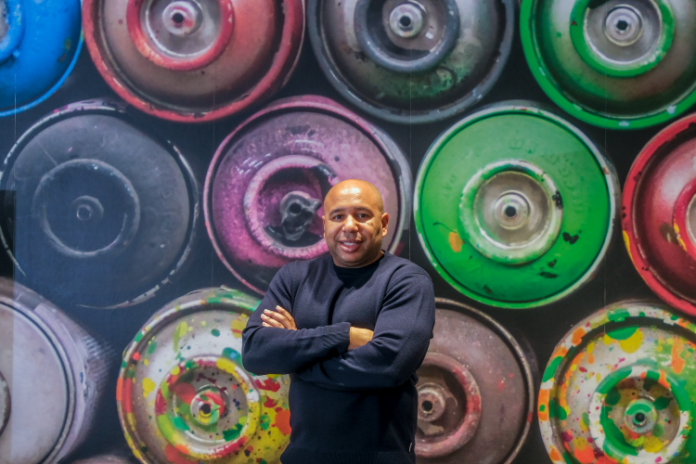The partnership between Destination Crenshaw and Lendistry, the latter of whom contributed a third of those funds, intends not only to bring money, jobs and culture to a marginalized and economically neglected area of Los Angeles but also to fulfill the original ambitions of both organizations as they combine community outreach and financial empowerment.
Downtown-based Lendistry, one of only four Black-led financial institutions in California, has grown by leaps and bounds since Chief Executive Everett Sands founded it in 2015. The Washington, D.C., native and University of Pennsylvania graduate began his career at a mortgage company before joining San Francisco-based Wells Fargo & Co. in Washington, D.C., and later in Orange County where he saw the need for a lender that could fill the gap left behind by the decline in community banks.
“Our mission is to be a source of capital and source of financial education for underserved businesses and their communities,” Sands said.
Lendistry estimates it has supported 570,000 small businesses with approximately $8.5 billion in loans and grants across the United States as of Dec. 28, according to its website. Those numbers reflect two yardsticks by which Sands said the company measures its success; a third is “innovation,” meaning its ability to build technology and to partner with other mission-based lenders. In that regard, it has also been effective: Lendistry, working as one of the 50 institutions providing financial resources to small businesses through the California Small Business Covid-19 Relief Grant Program, helped distribute almost $4 billion. Moreover, as the system’s administrator on behalf of the state of California, Lendistry processed 344,000 applications in 15 days.
The ‘right model’
The ‘right model’
Following a series of community discussions starting in 2015, the organization officially filed as a nonprofit in 2017 with the goal of revitalizing the 1.3-mile corridor of Crenshaw Boulevard between Vernon and Slauson avenues. Its leaders subsequently began working with Chicago-based architecture firm Perkins & Will — which designed the National Museum of African American History and Culture in Washington, D.C., and the Motown Museum in Detroit — to build an open-air museum that combined outdoor spaces of a quarter acre or less, known as pocket parks; reforestation efforts (including planting more than 800 trees); and more than 100 public artworks by Black artists in the community.
Destination Crenshaw, under the leadership of President and Chief Operating Officer Jason Foster, has combined artistic and cultural initiatives with workforce development components for economic revitalization. The Knoxville, Tennessee, native first began his career as a nonprofit worker after studying finance at Howard University where he first developed an understanding of the relationship between money and community. After joining Destination Crenshaw in late 2019 as a financial consultant, Foster jumped into the organization “full tilt” in 2020 when Covid-19 stalled its building and design efforts.
“It was really apparent to me that Destination Crenshaw had the right model,” Foster said. “It was community-led, and it was focused on all the aspects that would actually elevate the residents’ lives, along with the infrastructure improvement.”
Sands said the work Lendistry is doing with Destination Crenshaw effectively showcases what the lender is capable of as it grows as a financial institution and extends its reach in the communities it wants to help.
“There’s the obvious, which is small businesses and nonprofits that are connected to that Crenshaw corridor, and then the unforeseen businesses — the vendors, the suppliers and all the others that will be connected to these businesses,” Sands said.
Extending their reach
Extending their reach
Pouring resources directly into the community is the cornerstone of Destination Crenshaw’s operations and its most visible way to combat concerns that the project might fuel gentrification in the historically Black community.
“We believe that Crenshaw deserves to be a beautiful environment, and what that means is we are driving to improve it both aesthetically and environmentally,” Foster said.
Recognizing local criticism about the kinds of displacement that have occurred in the Chinatown and Boyle Heights neighborhoods, and noting that the corridor’s small businesses are its chief job creators, Foster said Destination Crenshaw works explicitly to help residents not just grow the community but combat the rising cost of living throughout Los Angeles, now and into the future.
“L.A. has a public infrastructure pipeline of $30 billion over the next 30 years, and it’s an opportunity for us to really look at both the traditional economy and the creative economy as opportunities to grow as our community does,” Foster said. “This is the largest intact Black community west of the Mississippi along Crenshaw Boulevard, and we intend that this project is going to keep it that way.”

